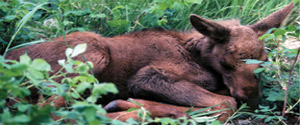| |

Yukon Flats National Wildlife Refuge
The third largest conservation area in the National Wildlife Refuge System, the 9 million acre Yukon Flats National Wildlife Refuge is located in eastern interior Alaska. It includes the Yukon Flats, a vast wetland basin bisected by the Yukon River. The basin is underlain by permafrost and includes a complex network of lakes, streams, and rivers. The area is characterized by mixed forests dominated by spruce, birch, and aspen. The Yukon Flats has a continental subarctic climate, with great seasonal extremes in temperature and daylight. Summer temperatures can reach 100 degrees F, warmer than any other comparable latitude in North America. Winter temperatures can drop to -70 degrees F.
The refuge supports the highest density of breeding ducks in Alaska, and includes one of the greatest waterfowl breeding areas in North America. In fact, most of Yukon Flats' birds are seasonal residents, fleeing south before the hard grip of winter closes over the land. Some 13 species, however (including boreal chickadees, great gray owls, spruce grouse, three-toed woodpeckers and ravens), remain on the refuge year around.
The same landscape that so favors waterfowl is also beneficial to furbearers, many of which, including beaver, lynx, marten, mink, muskrat and river otter, thrive on the water-laced flood plain. Moose benefit from the new growth encouraged by fire and flood, and can be found throughout the refuge. These large ungulates are the region's most important game animal; to the point that, for many subsistence hunters living on or around the refuge, "moose" is virtually synonymous with "meat."
Grizzly bears are found throughout the refuge in low concentrations, while the more common black bears tend to keep to the forested lowlands. Wolves can also be encountered anywhere on the refuge, but are rarely sighted. Dall sheep can be spotted on the alpine tundra of the White Mountains and Hodzana Highlands.
Getting There . . .
The refuge office is located in room 264 of the Federal Building at 101 12th Avenue in Fairbanks, Alaska. There is no visitor center, nor are there any public facilities, on the refuge itself. The refuge is located about 100 miles north of Fairbanks. Access is primarily by aircraft and boat. There are regularly scheduled commercial flights between Fairbanks and the seven villages in or near the refuge. Visitors may also drive the Steese Highway (a gravel road) from Fairbanks to the Yukon River, at Circle, and travel down the river via watercraft into the refuge. Charter service to remote lakes and gravel bars along rivers is also available from Fairbanks and Fort Yukon. Visitors may also drive up the Dalton Highway to the Yukon River Bridge and travel upriver about 5 miles to reach the refuge.


A rich ecosystem kept productive by fire and water.
Learn More>>

On December 1, 1978, President Carter used his authority under the Antiquities Act of 1906 to create 17 national monuments in Alaska, including the "Yukon Flats National Wildlife Monument."
Learn More>>
|
|
|
|

Environmental Education
Fishing
Hunting
Interpretation
Photography
Wildlife Observation
Learn
More >>


Yukon Flats NWR protects a large, natural and diverse ecosystem which provides an excellent living laboratory for scientific research. The refuge has a strong biological program. Staff members cooperate with universities, graduate students, and other state, federal and private agencies to study and monitor fish, wildlife and habitats. Recent studies have focused on black bears, chum salmon, in-stream water flows, lesser scaup, moose, northern pike, sheefish (or inconnu), white-winged scoters and yellow warblers.
The fire management program is one of the most active in the state. Refuge staff work with the Alaska Fire Service, Doyon, Limited (the Native Regional Corporation), local tribal governments and state agencies to maintain a near-natural fire regime. In areas near villages where large wildland fires must be suppressed, prescribed burns and mechanical treatments are conducted in cooperation with local villages to help maintain the role of fire in the ecosystem and to reduce wildfire risk.
Refuge staff members work directly with local residents, the Alaska Department of Fish and Game and the Federal Office of Subsistence Management to ensure that there are continued opportunities for subsistence uses by local rural residents within the refuge. This is accomplished by monitoring fish and wildlife populations and harvest levels, and working with local residents to develop practical and enforceable regulations.
There are frequent requests to access and use refuge lands for a variety of non-wildlife related purposes. One of the staff's management responsibilities is to ensure that all activities that are permitted on the refuge are consistent with its mission to conserve fish, wildlife and habitats in their natural diversity.
Outreach and environmental education are important management activities. Staff members work with local residents, schools, the media and other partners to educate and inform the public about the refuge, fish and wildlife, conservation practicies, and the types of activities that are encouraged on our National Wildlife Refuge System lands.
|
|

